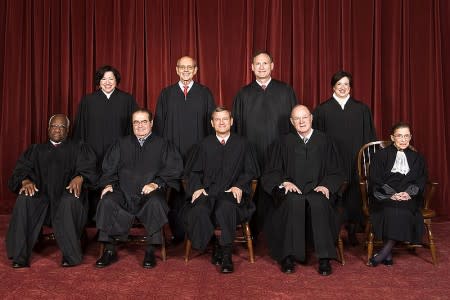What Supreme Court justices are saying on their summer vacations
Each year, Supreme Court justices spend their summer making public and private speaking appearances. And each season, a few notable quotes make it out in the press that show what the jurists are thinking.
As sure as the sun rises, Justice Antonin Scalia talks scathingly about the idea of the “living constitution.” And this summer is no exception.
Scalia appeared last week at an event in Telluride, Colorado, and took up his life-long defense of orginalism, the belief that the Constitution can only be understood in the context of how the Founders would address situations.
“The notion that the Constitution is a living document — you’ve got to be stupid to believe that,” Scalia said, as reported by a Telluride newspaper. “The Constitution is not a living document. It’s a dead document … It’s an enduring document.”
Scalia also told audience members that if they supported a living Constitution, one where case decisions are based on contemporary standards, they would “lose rights.” He also blamed the media for simplifying Supreme Court decisions by stereotyping the Justices as “good guys vs. bad guys.”
Last week, Justice Anthony Kennedy made headlines when he spoke about the Constitution at an event that was mostly devoted to the Magna Carta.
Kennedy said the Constitution, as originally written, was a “flawed document” because it allowed the institution of slavery to continue.
He also stated that the Founders were smart enough to allow constitutional rulings to change, by providing language that could be interpreted by different generations.
“The framers were wise enough to know that they could not foresee the injustices” of the future, Kennedy said at an event in San Francisco, “so they used general language.”
Justice Ruth Bader Ginsburg made news of a different type last week when she personally responded to a stranger who invited Ginsburg to her wedding.
Staci Zaretsky, a writer at a legal blog, sent the invitation to Ginsburg, even though she never met the Justice. Ginsburg responded with a handwritten note, apologizing for having other commitments on Zaretsky’s wedding day and complimenting Zarstsky for her “spirit-lifting note.”
In the Bronx, Justice Sonia Sotomayor found herself dealing with a crowd control situation, involving children.
Sotomayor, Hillary Clinton and several other luminaries attended an event at the Bronx Children’s Museum. Sotomayor then asked a group of children to show their appreciation by hugging Clinton and the other figures.
CNN was at the event and said it took about two minutes for Sotomayor to calm down the excited kids.
In comparison to recent summers, the other Justices have been quiet. Constitution Daily profiled the Justices last August and found them more active last year than this year when it came to appearances and media interviews.
Last July, Justice Kennedy spoke at length at the Chautauqua Institution in upstate New York, where he said he was opposed to cameras in the Supreme Court’s courtroom.
“From an institutional standpoint know that my colleagues and I are not immune from the instinct to grab a headline and I don’t want to think that my colleague asked a question for the benefit of the press. I don’t want to introduce that insidious dynamic between myself and my colleagues,” he said last summer.
Justice Ginsburg had given three interviews last summer before a public appearance at the National Constitution Center last September.
Scalia, as usual, continued his assault on the living constitution at a Montana appearance
Sotomayor spoke at Fordham University last July to a group of 90 elementary school students, while Justice Elena Kagan told an audience in Rhode Island last summer that some of the Justices still didn’t use e-mail directly.


